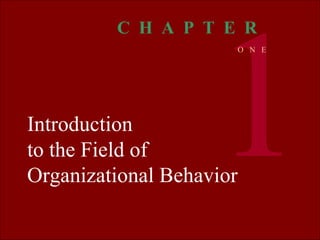Chap01
- 1. Introduction to the Field of Organizational Behavior 1 C H A P T E R O N E
- 2. Cisco Systems and Organizational Behavior Cisco Systems has leveraged the power of organizational behavior to becoming one of the worldâs leading high technology companies. Courtesy of Cisco Systems
- 3. What are Organizations? Groups of people who work interdependently toward some purpose Structured patterns of interaction Coordinated tasks Work toward some purpose
- 4. Why Study Organizational Behavior Organizational Behavior Research Understand organizational events Predict organizational events Influence organizational events
- 5. Emerging Trends in OB Globalization Changing work force Emerging employment relationships Information technology and OB Teams and more teams Business Ethics
- 6. Organizational Behavior Anchors Organizational Behavior Anchor Multidisciplinary anchor Scientific method anchor Contingency anchor Open systems anchor Multiple levels of analysis anchor
- 7. Systems Anchor of OB Outputs Inputs Organization Feedback Feedback Subsystem Subsystem Subsystem Subsystem
- 8. Intellectual Capital Human capital Knowledge that employees possess Structural capital Knowledge embedded in systems and structures Customer capital Value derived from satisfied customers, reliable suppliers, and others
- 9. Knowledge Management Defined Any structured activity that improves an organizationâs capacity to acquire, share, and utilize knowledge for its survival and success
- 10. Elements of Knowledge Management Sense making Knowledge awareness Empowerment Training Communication Rewards Individual learning Environmental scanning Grafting Experimentation Knowledge acquisition Knowledge sharing Knowledge dissemination
- 11. Knowledge Mapping at Hewlett-Packard Hewlett-Packard relies on knowledge mapping so that employees can quickly identify what knowledge is needed and where it is located. Knowledge maps guide employees to what knowledge is important and where it can be found. Courtesy of Hewlett-Packard
- 12. Organizational Memory Defined The storage and preservation of intellectual capital Includes both employee knowledge and embedded knowledge (structural capital)
- 13. Introduction to the Field of Organizational Behavior 1 C H A P T E R O N E












